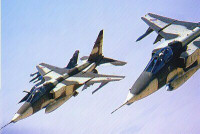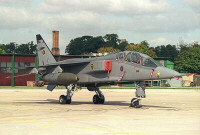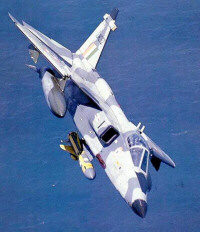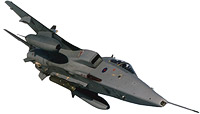SEPECAT Jaguar
Role: strike/ground attack, recce
Builder: SEPECAT (Dassault/British Aerospace cooperation)
Variants: A, B (T.2/2A, T.4/4A), E, S (GR.1/1A/1B, GR.3/3A), IS, IT, IM.
Operators: United Kingdom (1973-2007), France (1973-2001), Ecuador (1977-today), India (1979-today), Nigeria (1984-?), Oman (1977-today)
Developed cooperatively by the United Kingdom and France, the Jaguar is a light but capable strike aircraft. The Jaguar is a fast aircraft for its class, having a long sleek fuselage and two afterburning turbofan engines. It is used in the reconnaissance, advanced training, close air support, maritime attack as well as in the strike and interdiction role.
French Jaguars
Jaguar A is the original prototype and the French single-seat attack version. Jaguar E is the French tandem two-seat trainer variant with dual controls. Both were equipped with Adour Mk 101 engines, although they were quickly replaced by the Adour Mk 102. The French Jaguars saw combat in Africa and the Balkans, before the last squadron (EC.01.007) retired its final examples from operational use on July 1, 2005.
British Jaguars
Jaguar S designated GR.Mk1 (GR.1) by the Royal Air Force is the British equivalent of the Jaguar A with a laser in the nose. The Jaguar B is the RAF's advanced trainer designated T.Mk2 (T.2) and has a more advanced full suite nav/attack system. Although originally delivered with the Adour Mk 102 engines, they were quickly retrofitted with the more powerful Rolls-Royce/Turbomeca Adour Mk 104 turbofans. GR.1A is an upgraded GR.1 aircraft with the nav/attack system from the T.2 and self defense systems, which were also added to the T.2A upgrade. Reconnainssance aircraft are equipped with a centre-line pod housing five cameras and an IR linescan.
The GR.3 and T.4 are the last RAF standards of RAF GR.1s and T.2s respectively. The upgrade program included new cockpit displays, helmet-mounted sights, the ability to carry the new Advanced Short Range Air-to-Air Missile (ASRAAM) and other system improvements to further extend the life of the aircraft into the 21st century. Finally, in the twilight of their career with the RAF, 60 GR.3/T.4 aircraft were fitted with the Adour Mk 106 engine, a rebuild and enhanced version of the Mk 104 offering better reliability, maintainability and slightly more thrust.
Despite the upgrades, it was decided the Jaguar would ultimately leave RAF service in 2007. The last RAF Jaguar squadron, 6 Sqn, was planned to disband in October 2007, retiring its aircraft. However the date was brought forward by some six months to 30 April 2007, a decision which had been announced only six days earlier by the UK MOD. Only one GR.3A and one T.4 aircraft remain active for trials with QinetiQ at Boscombe Down, Wiltshire, UK. [AFM Jun07, p5]
International
All export Jaguar Internationals are based on the RAF's Jaguar B/S airframe. Export customers are Ecuador, India, Nigeria and Oman. India is the biggest Jaguar operator today, with Jaguar IS strike , IT trainer and IM maritime strike aircraft. The latter have the Agave radar in a reprofiled nose and are armed with BAe Sea Eagle anti-ship missiles.
While the original manufacturing countries of the Jaguar, France and the United Kingdom, have retired the Jaguar from air force service in recent years, India is still producing new aircraft of the type for the Indian Air Force (IAF). Currently, HAL's Bangalore production line is assembling the last batch of 20 single-seat Jaguars complete with the DARIN (Display Attack Ranging Inertial Navigation) II upgrade, including HOTAS, MFD, and new INS/GPS nagivation system. At Aero India 2007, February 2007, it was revealed that five of the 20 new Jaguars were ready for delivery with another three in final assembly. The eight were scheduled for delivery to the IAF before March 31, 2007, with the remaining 12 aircraft to be delivered within a year. [Source: AFM Apr07 p30]

French Jaguar A aircraft

T.2 twin-seat trainer

Sea Eagle equipped Jaguar IM


 Back to Index
Back to Index